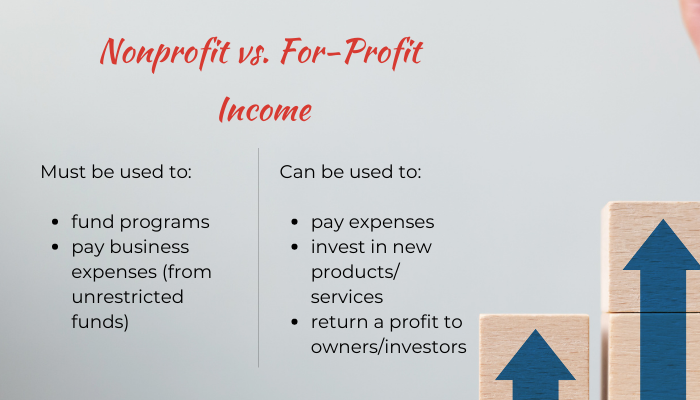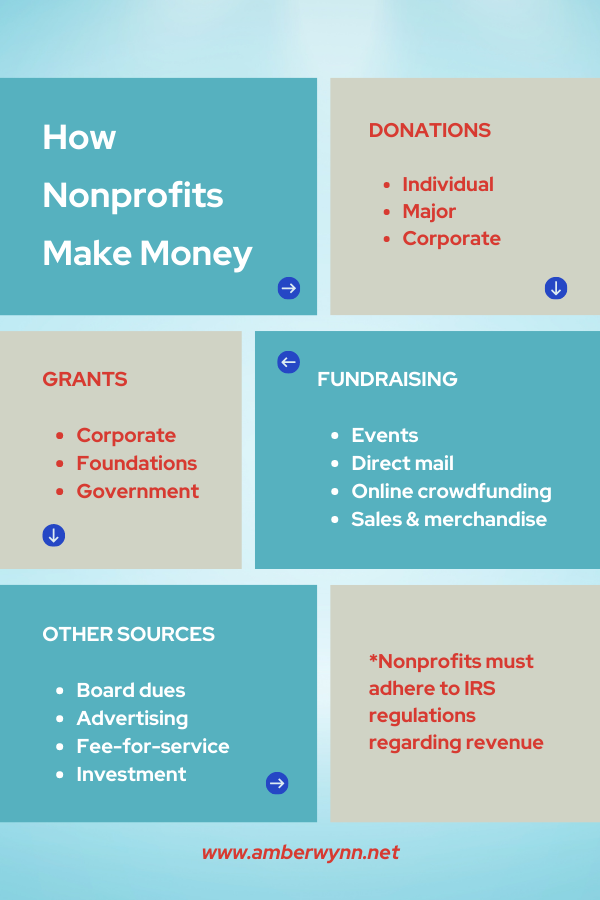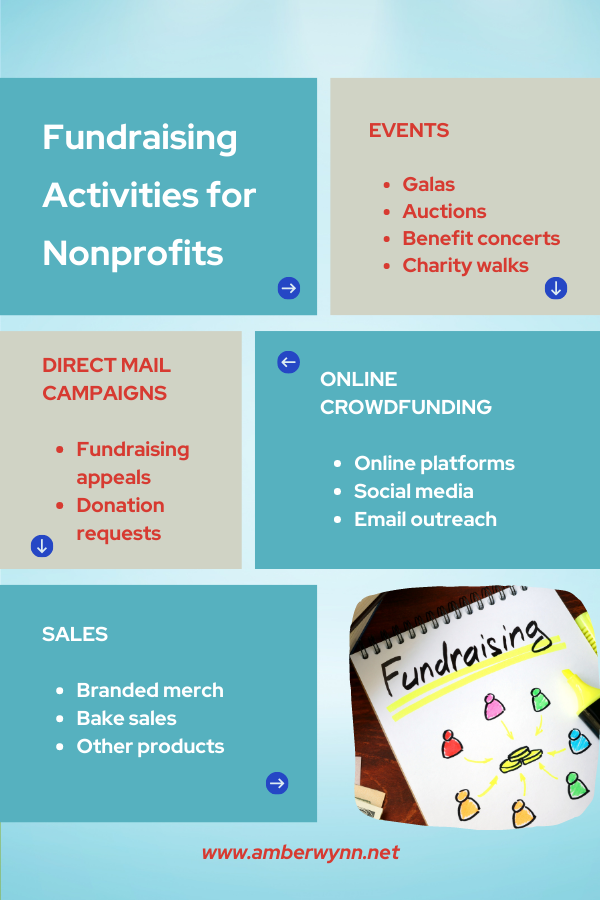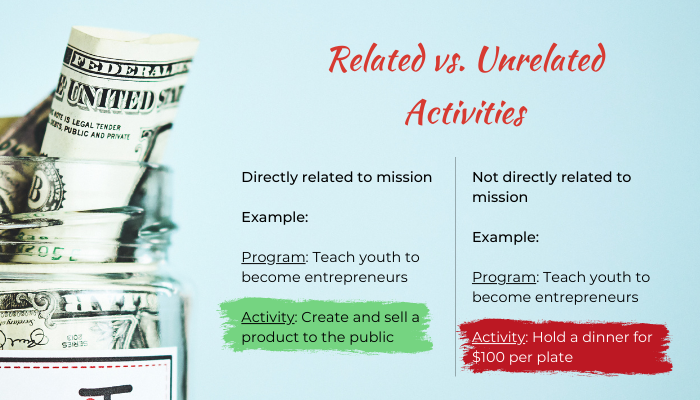How Do 501(c)(3) Organizations Make Money?
501(c)(3) nonprofit organizations operating under a specific section of the United States Internal Revenue Code play a crucial role in addressing various social issues and serving the community. Their primary objective is to promote charitable, educational, religious, scientific, or literary purposes. This tax exemption prevents them from generating profits for private individuals or shareholders.
While the focus of 501(c)(3) organizations is on fulfilling their mission and serving the public interest, funding is essential to support their operations and initiatives. This article looks at how nonprofits make money and sustain their activities, shedding light on how to develop multiple funding sources and strategies.
Whether you are curious about the inner workings of nonprofits, considering starting one yourself, or already running your own, it’s important to understand how nonprofits generate revenue.
So, let's delve into how 501(c)(3) organizations secure the financial resources needed to carry out their important work.
Nonprofit vs. For-Profit Income
Before discussing how nonprofit organizations make money, let’s first clarify the difference between nonprofit and for-profit income.
The main difference between a nonprofit and a for-profit business is their purpose. A for-profit business exists to make a profit for its owners, while a nonprofit exists to benefit the public.
For-profit businesses generate revenue by selling goods or services to customers. They can then use this revenue to cover the cost of their expenses, invest in developing new products or services, and return a profit to their owners and investors.
On the other hand, nonprofits generate revenue through donations, grants, sales, and other forms of support, which must be used to fund the nonprofit’s programs and activities that benefit the public.
Public charities with 501(c)(3) tax-exempt status are required to secure a significant percentage of their revenue from multiple funding sources. This actually means multiple funding sources, as in a public charity cannot receive its funding from one funder but rather from multiple funders.
For example, all of its funding comes from Microsoft. It must come from Microsoft, Ahmanson, Ford Foundation, Coca-Cola, Individual donors, etc.)—a nonprofit cannot have just one funding source; otherwise, that shifts it to a private foundation.
Some examples of different ways a nonprofit can generate revenue:
Fundraising campaigns
Sponsorships
Receiving bequests
Applying for grants
Board dues
Holding events
A healthy charity will have at least 10 diversified revenue streams to ensure that it can cover operational expenses and provide services to the public.
Sources of Income for 501(c)(3) Organizations
Nonprofits rely on various sources of income to sustain their operations and fulfill their missions.
Donations and grants
Donations and grants are vital sources of revenue for 501(c)(3) organizations.
However, nonprofit organizations cannot be sustained by grants alone. Grants are not guaranteed, and they can take 20-100 hours to prepare. Not to mention that grant writers charge $2,000-$10,000 to prepare a proposal/application.
Let’s break down donations and grants further.
Let’s break down donors and grants further.
Individual donors
Individual donors contribute to nonprofits through personal financial contributions. These can be in the form of one-time or recurring donations. Nonprofits often engage in fundraising campaigns and initiatives to attract and retain individual donors.
Major donors
Major donors are individuals who make substantial financial contributions to nonprofits. These donors have the capacity to make significant donations. Nonprofits cultivate relationships with major donors through personalized stewardship and recognition efforts.
Corporate sponsors/grants
Corporations and businesses provide support to nonprofits through corporate sponsorships and grants. These partnerships involve financial contributions, employee volunteer/matching programs, and cause-related marketing campaigns. Nonprofits seek out corporate sponsors that align with their mission and values.
Foundation grants
There are several types of Foundations: Private (Corporations), Family, Community, and Public. Foundations provide grants to support specific programs, initiatives, or general operations of 501(c)(3) tax-exempt nonprofits. Nonprofits should only apply for grants from foundations that share their focus areas or goals.
Numerous foundations provide grants to nonprofits across various sectors and causes. Here are some well-known foundations that offer grants to nonprofit organizations:
The Bill & Melinda Gates Foundation focuses on global health, poverty alleviation, and education.
The Ford Foundation supports initiatives related to social justice, economic opportunity, and democratic values.
The Open Society Foundations was founded by George Soros and supports projects that promote democracy, human rights, social justice, and education. It provides grants to organizations worldwide.
The Rockefeller Foundation focuses on initiatives related to global health
Government grants
Government entities, including federal, state, and local governments, play a crucial role in supporting the work of nonprofit organizations through grant funding. These grants aim to address critical societal needs and advance various sectors such as education, healthcare, and social services.
Government grants are highly competitive, and nonprofits must meet specific criteria and comply with regulations to qualify for funding. These criteria typically include demonstrating alignment with the government’s priorities, outlining a clear plan for achieving intended outcomes, and showcasing the organization’s capacity to effectively manage grant funds.
Government grants for nonprofits often have specific application processes, deadlines, and reporting requirements. Nonprofits are required to submit comprehensive proposals that outline their mission, proposed activities, budget plans, and anticipated impact. The evaluation process may involve review panels, scoring criteria, and rigorous assessments of the organization’s financial and operational capacity.
Fundraising activities
Fundraising is another aspect of funding the operations and programs of 501(c)(3) organizations. This entails employing various strategies to generate funds from individuals, businesses, and other entities.
Some ways to raise funds include:
Events: These events can take various forms, such as galas, auctions, benefit concerts, charity walks/runs, or community festivals. Events provide an opportunity for donors to contribute while enjoying a memorable experience.
Direct mail campaigns: Direct mail campaigns involve sending fundraising appeals and donation requests to potential supporters. Nonprofits create compelling stories/videos highlighting their mission and impact and include a call-to-action, typically with a donate button for recipients to make a financial contribution.
Online crowdfunding: With the advent of digital platforms, online crowdfunding has become an increasingly popular fundraising method for nonprofits. Organizations can create online fundraising campaigns on dedicated platforms, leveraging social media and email outreach to spread the word. Supporters can donate directly through these platforms, often accompanied by personalized messages and updates.
Sales: Nonprofits often generate revenue through sales of various products. This can include branded merchandise, such as t-shirts, tote bags, or mugs, which supporters can purchase to show their support. Additionally, nonprofits may engage in fundraising sales campaigns, offering products like popcorn, chocolate, cookie dough, or other items, with a portion of the proceeds going toward their cause.
Effective fundraising requires thoughtful planning, engaging storytelling, and clear communication about the impact of donations. They should be specifically tailored to the donors/supporters to make the most of fundraising activities.
Additional sources of income
Nonprofits have several additional sources of income that contribute to their financial stability and sustainability beyond donors, grants, and fundraising.
These sources include:
Board dues: Nonprofit organizations collect dues from their board members. These dues can contribute to the organization's financial resources and help cover operational expenses or support specific programs or initiatives.
Advertising: Nonprofits may offer limited advertising opportunities in their publications, newsletters, websites, or events. By partnering with businesses or other organizations, nonprofits can generate limited revenue through advertising fees, sponsorships, or partnerships. (Limited because the revenue generated from unrelated business income can be taxed— revenue sources would be considered unrelated business.)
Contracts: Nonprofits can secure contracts with government agencies, private entities, or other organizations to provide specific services or expertise. These contracts can be a significant source of income, particularly for organizations with specialized skills or knowledge in a particular field.
Fee-for-service income: Fee-for-service is typically a fee for delivering a direct service, like afterschool care, tutoring, sports or arts-based programs, etc. Some nonprofits offer specialized services or programs and charge for them. These services range from educational workshops and training sessions to consulting or professional development programs. By charging a fee for these services, nonprofits can generate revenue while leveraging their expertise to benefit individuals, businesses, or other organizations.
Investment income: Investment income refers to the returns generated from investing a nonprofit organization's financial assets. Nonprofits often maintain reserves or endowments to support their operations or future initiatives. These reserves are invested in various financial instruments such as savings accounts, bonds, stocks, or mutual funds. The income earned from these investments can provide a steady stream of revenue for the organization.
Again, to be sustainable, nonprofits should have at least 10 income streams and not rely on grants for funds.
Earned income: related and unrelated
Earned income refers to the revenue generated through the nonprofit's provision of goods or services. This allows nonprofits to diversify their revenue streams and reduce dependence on external sources.
Earned income can come from various activities, such as what we mentioned in the previous section.
Program-related fees: Nonprofits may charge fees for the services they provide or the programs they offer. For example, a nonprofit educational organization may charge tuition fees for courses or workshops they conduct.
Membership fees: Nonprofits may offer membership programs that provide exclusive benefits or access to certain resources. Members are typically required to pay annual or monthly fees to maintain their membership.
Sale of goods or merchandise: Nonprofits may sell products or merchandise that align with their mission. This can include items like books, apparel, artwork, or other goods directly related to the organization’s cause or activities.
Ticket sales: Events, such as concerts, conferences, or fundraisers, may generate income through ticket sales. Attendees purchase tickets to access the event and participate in the activities.
Facility rentals: If a nonprofit owns or manages a facility, such as a conference center, theater, or community space, it may generate revenue by renting out the facility to external parties for meetings, events, or performances.
Consultancy or professional services: Nonprofits with specialized knowledge or expertise may offer consultancy or professional services in their field. They can provide training, workshops, research, or other services for a fee.
Earned income allows nonprofits to leverage their skills, resources, and assets to generate sustainable revenue. By providing valuable services or products, nonprofits can not only support their mission but also create self-sufficiency and financial stability. It’s important to note that earned income should be aligned with the organization’s tax-exempt purpose and not become the primary focus, as the primary goal of nonprofits is to serve the public and fulfill their charitable mission.
Earned income falls under two categories: Related activities and Unrelated activities.
Related activities
These are activities directly related to the nonprofit’s mission.
For example, a nonprofit teaches youth to become entrepreneurs. Part of their training is creating and selling a product to the public. Sales from this activity are program-related, and revenue, as a result, is not taxable.
Unrelated activities
Unrelated activities refer to income-generating endeavors not directly aligned with a nonprofit’s mission. Examples include corporate sponsorships, advertising, and product/merchandise sales.
While these activities can provide additional financial support, nonprofits must be aware of the potential tax implications. This type of income is subject to Unrelated Business Income Tax (UBIT).
The standard UBIT rate is 35%. If a nonprofit’s unrelated activities exceed a certain threshold, known as the “red flag” amount (currently set at 50%), it may attract scrutiny from the IRS. Nonprofits should navigate UBIT regulations carefully to ensure compliance and proper financial management.
Regulations and Restrictions on Income Generation
The revenue earned by a nonprofit organization must be reinvested back into the organization to cover various business expenses. These expenses include operational costs, accounting services, legal support, marketing efforts, program development, IT infrastructure, fundraising activities, etc.
However, how a nonprofit allocates its revenue is determined by the funders. Unrestricted funds can be utilized for any expenses that directly support the organization's mission. On the other hand, restricted funds are designated by funders for specific purposes such as program funding, operational support, capacity building, or specific initiatives. Nonprofits must adhere to the guidelines set by the funders when utilizing restricted funds.
In addition to managing revenue and expenses, nonprofit organizations must navigate various IRS regulations and requirements to maintain their 501(c)(3) status.
These are the criteria that govern public charities:
IRS regulations and requirements: Nonprofits must comply with IRS rules related to maintaining their tax-exempt status. This includes filing annual taxes (such as Form 990), adhering to financial accounting standards, and meeting specific criteria to qualify for tax-exempt status.
Limitations on political activities and lobbying: 501(c)(3) tax-exempt nonprofits are subject to restrictions on engaging in political campaign activities and lobbying. While they can advocate for their causes within certain limits, excessive involvement in political activities can jeopardize their tax-exempt status.
Public disclosure requirements: Nonprofits are required to make certain information publicly available, such as their financial statements, Form 990, and details about their programs and governance. Transparency and public accountability are essential for maintaining public trust.
Restrictions on private benefit and excessive compensation: Nonprofits must avoid providing undue benefits to individuals (in particular, the Board of Directors) or organizations. They should not serve the private interests of individuals, and compensation for employees and executives should be reasonable and in line with the organization's mission and financial resources.
Understanding and complying with these regulations is crucial for nonprofit organizations to uphold their legal and ethical responsibilities, maintain their tax-exempt status, and ensure transparency in their operations. By doing so, nonprofits can build trust with stakeholders and effectively pursue their mission to impact their communities positively.
Related reading: What Are Nonprofits Allowed to Spend Money On?
Financial Management and Accountability
Financial management and accountability are vital for nonprofit organizations to ensure the responsible and effective use of resources. Key aspects of financial management and accountability include:
Budgeting and financial planning
Nonprofits must develop and maintain comprehensive budgets that align with their mission and strategic goals. This involves estimating income, forecasting expenses, and setting priorities for resource allocation. Effective financial planning allows nonprofits to make informed decisions, allocate funds efficiently, and ensure the organization's financial sustainability.
Transparent reporting and auditing
Nonprofits should prioritize transparent reporting of their financial activities. This includes regularly publishing financial statements, such as Form 990, on a trusted site such as GuideStar, making them easily accessible to stakeholders. An annual audit by an independent accounting firm adds credibility to the financial information and demonstrates the organization's commitment to transparency and accountability.
Compliance with IRS regulations and reporting
Nonprofits must stay compliant with IRS regulations specific to their tax-exempt status. This includes filing required forms and reports accurately and on time, such as the annual Form 990. Nonprofits should also adhere to specific guidelines regarding fundraising activities, recordkeeping, and documentation to maintain their tax-exempt status and uphold their legal obligations.
Work Toward Financial Stability and Stewardship
Nonprofits rely on various income sources to ensure financial sustainability and effectively pursue their missions. Through donations, grants, corporate sponsorships, merchandise sales, and fee-for-service arrangements, organizations can diversify their funding streams, reducing dependence on any single source.
The importance of financial sustainability cannot be overstated, as it enables nonprofits to maintain and expand their impact over the long term. By employing sound financial management practices, implementing transparent reporting, and adhering to IRS regulations, nonprofits establish trust with stakeholders and foster ongoing support.
To support their cause and ensure financial sustainability, nonprofits must continually strive to diversify their funding sources. By exploring innovative fundraising strategies, cultivating relationships with a wide range of donors, sponsors, and grantmakers, and adapting their approaches as needed, nonprofits can expand their reach and secure the resources necessary to sustain their programs and initiatives.
In a landscape that demands adaptability and resilience, nonprofits that embrace diverse funding sources and consistently evaluate and refine their fundraising efforts are well-positioned to thrive and make a lasting impact in their communities.
FAQ
Can nonprofit employees make money?
Yes, nonprofit employees can earn income through salaries and wages. Nonprofits compensate their employees based on their skills and qualifications, ensuring they can attract and retain qualified professionals to carry out their missions effectively.
Can the founder of a nonprofit make money?
Yes, the founder of a nonprofit can receive a salary or compensation for their work if they serve as the Executive Director (not Board President). However, the amount must be reasonable and in line with industry standards.
What can nonprofits do with profits?
Nonprofits must use the revenue they generate to cover the organization's business expenses, rather than taking it as direct profit like for-profit businesses. This includes paying salaries, covering the costs of implementing/expanding programs and providing direct services, covering business expenses, establishing reserves, contributing to endowments, providing scholarships, and making investments in line with their mission.







